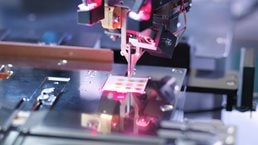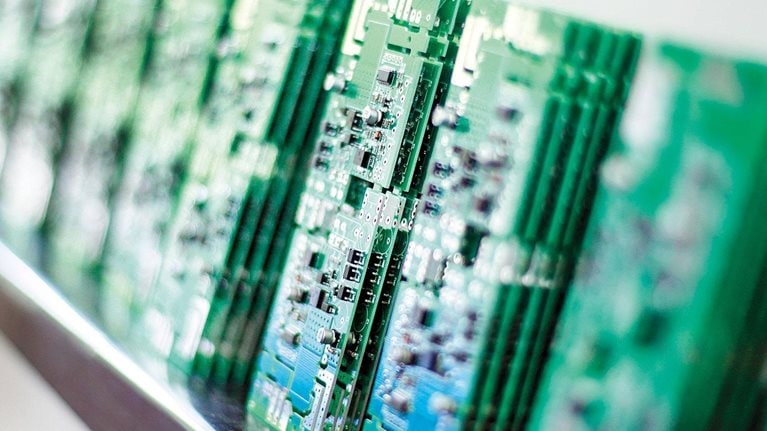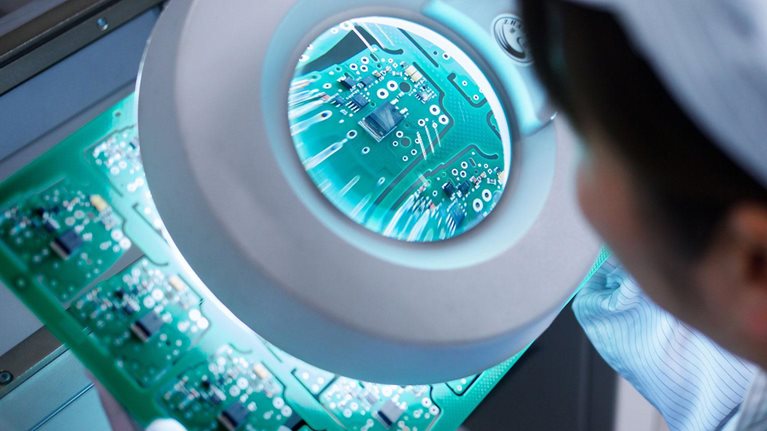The semiconductor sector is highly cyclical, with profitability typically rising and falling in tandem with overall economic trends. A review of the past two decades shows that earnings before interest and taxes (EBIT) for major semiconductor players were highest in 2000, at the height of the dot-com craze (Exhibit 1). Profits reached their lowest points in 2001, when the economy struggled, and during the recession from 2008 to 2009. As with the semiconductor sector as a whole, the memory segment is strongly influenced by economic trends. From 2008 through 2009, for instance, memory’s EBIT plummeted as consumer demand fell for PCs, mobile phones, and other high-tech products.

Although a weak economy may contribute to poor results, fundamental structural factors have an even greater influence on the memory sector. In fact, they may largely explain why memory suffers more than other semiconductor segments during downturns and why memory players were not able to create economic value between 1996 and 2012, even though their technological innovations significantly contributed to the semiconductor industry’s growth.1 First, competition was intense. Second, both DRAM and NAND flash were commoditized and primarily differentiated based on price per gigabyte.2
Over the past few years, however, the memory segment has been profitable even though products—particularly DRAM—are still commoditized. The weighted average EBIT for memory players has edged upward since 2012 and has been higher than the semiconductor-industry average since that time (Exhibit 2). The past two years have shown particularly strong results, with the weighted average EBIT for the memory sector coming in above 15 percent since the second quarter of 2013 and reaching a peak of 25 percent in 2015. Structural changes are primarily responsible for memory’s recent performance: higher barriers to market entry, segment consolidation in DRAM, more diversified demand, lower-than-expected capacity expansion because of a slowdown of Moore’s law, and more rational player behavior.

Despite these structural shifts, the memory segment’s recent profitability may not continue indefinitely. While DRAM players should continue to benefit from segment consolidation, they may have to contend with an oversupply, as well as competition from next-generation memory technologies. The NAND segment is seeing some shifts, including increasing moves to vertical and horizontal integration, that potentially offer opportunities to improve overall profitability. However, NAND faces new competition from entrants at the system level. The transition to 3-D NAND and next-generation nonvolatile-memory (NVM) technologies may pose significant challenges for the NAND segment. For all memory-segment players, the emergence of China’s semiconductor sector poses many questions.
This article reviews the structural changes that have led to memory’s recent strong performance. We also discuss the greatest challenges that DRAM and NAND players face.
A good run: Structural factors behind memory’s strong performance from 2012 to 2015
Segment consolidation, one of the trends that has helped improve memory EBIT, is specific to DRAM. All other structural changes have benefited both DRAM and NAND players.
DRAM-segment consolidation
Since 2012, most of the memory sector’s strength can be attributed to consolidation within the crowded DRAM segment. In 1995, the top ten DRAM players accounted for about 80 percent of market share. Since then, the market has been consolidating. By 2012, three players led the market: Micron Technology, Samsung, and SK Hynix. In 2013 and 2014, these three accounted for more than 90 percent of market share. In contrast, the number of NAND players has been relatively small since the technology was launched, so consolidation has not been a major factor in this market. Exhibit 3 compares consolidation trends for DRAM and NAND.

The commoditized nature of DRAM products helps explain the consolidation trend. When demand fell, players tried to gain a competitive edge by decreasing prices sharply, since price per gigabyte was the primary product differentiator. In addition, memory players tended to run fabs at full capacity, even when demand dropped, because their fixed costs (including depreciation) were high. This practice resulted in severe oversupply when the market slowed, putting prices and margins under pressure. Together, the price decreases and high supply caused DRAM players to suffer more than other segments when demand declined.
DRAM consolidation accelerated between 2008 and 2012 because the economic downturn reduced demand in major end markets. In addition, the manufacture of PCs slowed after the 2011 floods in Thailand curtailed the supply of hard-disk drives. Companies that exited the market in response to these pressures include Qimonda, a pure-memory player that was a German spinoff of Infineon Technologies. Despite the company’s power-saving trench technology and its leadership in the transition to 300-millimeter wafers, Infineon/Qimonda never displayed high profitability and was heavily dependent on revenues from DRAM for PCs and servers. After the 2008 economic crisis decreased DRAM prices and revenues, Qimonda filed for bankruptcy. Elpida Memory, a leading Japanese player, suffered a similar fate because the decline in DRAM prices and a strong yen made its cost structure unsustainable when demand decreased. Elpida Memory went bankrupt in 2012 and was acquired by Micron.
In addition to pure-memory players, diversified integrated device manufacturers also suffered from low memory-segment profitability and high segment volatility, causing Hitachi, IBM, LG Electronics, Mitsubishi Electric, NEC, and Texas Instruments to exit the sector. Today, there are only three major players in DRAM, accounting for more than 90 percent of market share: Micron, Samsung, and SK Hynix. The industry structure is similar with NAND, where Micron/Intel, Samsung, SanDisk/Toshiba, and SK Hynix dominate.
Barriers to entry: Large scale and strong technological capabilities are essential
To be competitive in the memory segment, players must have large scale and strong technological capabilities. These requirements have created high barriers to entry for the past 20 years, and no serious new competitors have emerged over the past 10. The size of leading-edge nodes decreased from 130 nanometers in 2001 to just over 20 nanometers in 2014. This “shrink” caused fab and process-development costs to soar by 13 percent annually, with the steepest increases reported over the past few years (Exhibit 4). The cost of building a new fab with the technology required for a leading-edge node can reach as much as $10 billion, up from about $1.7 billion in 2001.3 Memory players are under pressure to migrate all capacity to a smaller node size because memory produced on them is cheaper from a dollar-per-bit perspective. (More than 90 percent of memory devices today are produced on leading-edge nodes, although the slowdown of NAND node-size shrink may reduce that number, as discussed later.)

Technology requirements also pose a challenge for entering the memory segment. Currently, only a few leading semiconductor companies have all the necessary success factors: sufficient intellectual property, strong design and process-engineering capabilities, and a track record for improving yield to sustainable levels. These scale and capability requirements help explain why the number of players with leading-edge nodes (in memory and logic) fell from 29 in 2001 to 6 today.
A broader demand base
Before 2008, the memory segment primarily depended on sales of PCs and, to a much lesser extent, enterprise servers. With no other sectors providing a meaningful buffering effect, demand varied greatly as PC sales surged or lagged. Between 2007 and 2009, for example, demand for desktop PCs dropped by 18 percent, resulting in an oversupply of DRAM.
Today, however, the demand base for memory products is much broader, primarily because of rising demand in the mobile sector. Current smartphones and tablets require much more memory than previous mobile devices, which has contributed to the sector’s consistent double-digit growth in recent years. This increase has helped counterbalance the continued decline of PC sales, which fell 19 percent between 2011 and 2014. In fact, the mobile segment overtook PCs in demand for DRAM in 2014.
Other developments that have helped diversify the demand base include the increased need for data centers for Internet and cloud applications, as well as the emergence of applications for NAND in enterprise storage. For instance, the number of so-called hyperscale data centers and other cloud data centers is growing rapidly and may reach a market size of $17 billion in 2018, up from $9 billion in 2013, according to a Bernstein analysis.
Supply: Slowdown in bit-capacity growth
Memory bit capacity is determined by two factors: capacity for memory wafers worldwide and the number of bits per wafer. Over the past few years, slower growth in both factors has prevented the segment from running into an oversupply situation, as was often the case before 2012.
According to iSuppli, a research house, the capacity for memory wafers for DRAM and NAND more than doubled between 2005 and 2008, going from about 850,000 wafer starts per month to about 2,100,000. This increase led to an oversupply in memory, especially DRAM. Between 2008 and 2015, however, no significant DRAM capacity was added; in fact, consolidation of the segment led to DRAM output declining by 15 percent over this period (Exhibit 5). NAND wafer-capacity output grew by 86 percent from 2008 to 2015, while revenue for this segment increased by 180 percent.

The number of bits per wafer—the second factor that influences memory bit capacity—has traditionally been driven by node-size shrink. For many years, shrink doubled roughly every two years, according to Moore’s law. But semiconductor companies now have difficulties maintaining this pace because of increasing technological challenges. As a result, the year-on-year increase in bits per wafer significantly slowed in 2015 for both DRAM and NAND, as Exhibit 5 shows. Toshiba already announced that a shrink of NAND below the current leading edge of 15 nanometers does not make economic sense and stated that the further increase in bits per wafer will have to come through other approaches, such as 3-D NAND. The latest consensus forecast of the International Technology Roadmap for Semiconductors also states that NAND node shrink has slowed.
Player behavior: A new focus on profitability over market share
For many years, memory players prioritized market-share gains over profitability in this much-commoditized segment, with many expanding capacity even though greater chip supply drove prices down and had little positive impact on revenues. Samsung, for instance, aggressively invested in capacity to become the leading DRAM player. The focus on market share and capacity expansion, which players in many other semiconductor segments also displayed, has long been a factor in the industry’s low profitability.

Would you like to learn more about our Semiconductors Practice?
In some cases, government subsidies or credits may have skewed the market and encouraged players to expand or kept them in business. These subsidies and credits were popular because many governments considered the memory sector to be strategically important, and they wanted to help companies recover from difficult circumstances. Several countries still offer subsidies and incentives, particularly those in Asia, where most memory capacity is located. However, subsidies and incentives are now less common in other locations, so their impact is more limited.
Although the memory market is still very competitive, players have behaved more rationally since 2012, when consolidation reduced the number of major DRAM players to three. These top three players—Micron, Samsung, and SK Hynix—are now clearly focused on profitability, as transcripts of recent earnings calls demonstrate. For instance, some leaders mentioned that they wanted to focus on profit maximization; others announced that they would not add capacity to gain market share or stated that they do not expect to undertake aggressive expansion efforts. The new profit-focused outlook is also reflected in the fact that some players have started to employ experts from capital-intensive industries with commoditized products, such as oil and gas.
Questions for the memory segment
Although the memory segment appears to be on the right track, several challenges lie ahead. Some are specific to DRAM or NAND, while others will affect both segments.
A possible mismatch between supply and demand in DRAM
DRAM supply may continue to outstrip demand, creating pressure on prices, margins, and profitability. The following factors are among those contributing to this situation:
- a continuing decline in PC unit sales, which still constitute 25 percent of memory demand
- a slowdown in growth of the smartphone end market
- an increase in DRAM supply, resulting from the shift to smaller node sizes and increased investment in capacity
Consider a few recent developments. Samsung began shipping 20-nanometer nodes in March 2014, and Micron and SK Hynix followed. The transition from 25-nanometer to 20-nanometer node size (and smaller) will increase bit capacity by 30 percent at existing production facilities. There is also clear evidence that leading companies plan to increase current production capacity. For example, Samsung is building a $14 billion memory fab in South Korea, and SK Hynix recently announced that it plans to invest $26 billion in the construction of two new memory fabs over the next ten years. This may result in periods of oversupply in DRAM as new capacity comes online.
The transition to 3-D NAND
Compared with DRAM, the overall prospects for NAND may initially look robust. The overall market size and demand for NAND chip-level products is expected to grow by about 10 percent annually, reaching a market size of more than $40 billion in 2017. But the ongoing shift in the underlying architecture of NAND—the move from planar to 3-D—may create challenges.
The transition to 3-D NAND will require massive investments and may result in periods of supply-demand imbalance. The total required industry investment for building and retooling manufacturing sites is expected to be in the range of $35 billion to $45 billion over the next three to five years. Currently, all players are ramping up yields of 3-D NAND. Samsung was the first to make a concerted push into 3-D NAND technology; Intel, Micron, SanDisk/Toshiba, and SK Hynix are expected to start ramping up 3-D NAND in 2016. Companies making this move will have to deal with several issues. For instance, challenges with 3-D stacking still remain, and the opportunity in scaling (with respect to number of layers) remains to be seen. Therefore, some players are continuing to invest in 15-nanometer planar NAND to ensure they obtain continued cost improvements while 3-D is ramping up.
One challenge to the successful forward integration of NAND chip-level players comes from new entrants at the system level. NAND chip-level players Intel, Micron, Samsung, SanDisk/Toshiba, and SK Hynix have successfully increased profitability and captured additional value through forward integration to the NAND system level, with offerings such as solid-state drives for enterprise data centers and cloud computing, and embedded solutions. However, large high-tech companies, such as Apple and Google, are thought to have begun designing their own NAND chip-based systems, and other large players may follow if the early adopters are able to keep pace with rapidly evolving NAND technology. The NAND segment is also likely to see increased M&A activity as forward integration gains momentum. For instance, the recently announced $19 billion acquisition of SanDisk by Western Digital Technologies was partly driven by opportunities in forward integration.
Developments affecting DRAM and NAND
All players will need to address two issues in coming years, and there is much uncertainty in both areas. The first development involves the emergence of next-generation NVM memory. Newly emerging NVM technologies, which offer increased speed and durability compared with NAND, are expected to begin playing a significant role and encroach on the market share of both DRAM and NAND by 2019 or 2020. For instance, Intel announced that it plans to reenter memory manufacturing, which it left in 1985, specifically for 3-D XPoint, a type of NVM.4 SanDisk has been working on new NVM technologies and recently announced a collaboration with Hewlett-Packard on its resistive-RAM technology. However, adoption of these new technologies will require significant changes in computer-system architecture, including applications and operating systems.
The second issue relates to the role of China. Given the resources at its disposal, China can significantly alter the memory segment’s future structure and economics through its investments. Already, large Chinese players have been aggressively pursuing a significant role in the memory segment. For instance, Tsinghua Unigroup made a $23 billion bid for Micron and a bid for minority investment in SK Hynix, but both were unsuccessful. Tsinghua has also hired leading executives from the Taiwanese DRAM industry. In other developments, current memory-market leaders have been expanding their engagement with China. Samsung recently established its first large 3-D NAND fab in China, while Intel announced that it will invest $5.5 billion to convert its fab in Dalian, China, into a facility that can produce 3-D NAND and 3-D XPoint. On the investment side, Western Digital has announced a proposed minority investment by Unisplendour of about $3.8 billion.
Over the past three to five years, the memory segment has transformed into a more stable and profitable part of the semiconductor space. Players have the opportunity to create economic value by pursuing a diverse set of applications and moving up the stack into devices and systems. However, they will also face major challenges, including supply-demand imbalances (which may be temporary), significant technology transitions, uncertainties related to China, and the emergence of new technologies. Companies that are flexible and rapidly adjust their strategies to suit the evolving memory landscape may increase their chances of success in the exciting times ahead.


